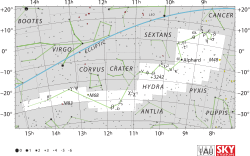Gamma Hydrae

| |
| Observation data Epoch J2000.0 Equinox J2000.0 | |
|---|---|
| Constellation | Hydra |
| Right ascension | 13h 18m 55.29719s[1] |
| Declination | –23° 10′ 17.4514″[1] |
| Apparent magnitude (V) | +2.993[2] |
| Characteristics | |
| Spectral type | G8 III[3] |
| U−B color index | +0.645[2] |
| B−V color index | +0.920[2] |
| Astrometry | |
| Radial velocity (Rv) | –5.4[4] km/s |
| Proper motion (μ) | RA: +68.99[1] mas/yr Dec.: –41.85[1] mas/yr |
| Parallax (π) | 24.37 ± 0.15[1] mas |
| Distance | 133.8 ± 0.8 ly (41.0 ± 0.3 pc) |
| Absolute magnitude (MV) | –0.15[3] |
| Details | |
| Mass | 2.94[3] M☉ |
| Radius | 13[5] R☉ |
| Luminosity | 115[3] L☉ |
| Surface gravity (log g) | 3.02[6] cgs |
| Temperature | 5,087[6] K |
| Metallicity [Fe/H] | –0.06[6] dex |
| Rotational velocity (v sin i) | 8[7] km/s |
| Age | 372[3] Myr |
| Other designations | |
Gamma Hydrae (γ Hya, γ Hydrae) is a star in the equatorial constellation of Hydra. It has an apparent visual magnitude of 3.0,[2] placing it second in brightness among the members of this generally faint constellation. Based upon parallax measurements made during the Hipparcos mission, this star is at a distance of around 133.8 light-years (41.0 parsecs) from Earth.[1]
The spectrum matches a stellar classification of G8 III,[3] with the luminosity class of III indicating it has evolved into a giant star after exhausting the supply of hydrogen at its core. The interferometry-measured uniform disk angular diameter of this star is 2.96 ± 0.15 mas,[9] which, at its estimated distance, equates to a physical radius of roughly 13 times the radius of the Sun.[5] It has nearly three[3] times the mass of the Sun and is radiating 115[3] times the Sun's luminosity from its outer atmosphere at an effective temperature of 5,019 K.[3] This heat gives it the yellow glow of a K-type star.[10] Despite having reached an advanced stage in its evolution, it is considerably younger than the Sun with an age of around 372 million years. This is because higher mass stars consume their nuclear fuel at a more rapid rate.[3]
In culture
γ Hya appears on the flag of Brazil, symbolising the state of Acre.[11]
In the television show Star Trek: The Original Series, the starship Enterprise visits a planet named Gamma Hydrae IV in the episode "The Deadly Years". Within the same fictional setting, a region of space designated "Section 10" of Gamma Hydrae lies within a demilitarized area called the Klingon Neutral Zone. This comes into play during the Kobayashi Maru scenario depicted in the film Star Trek II: The Wrath of Khan.
References
- 1 2 3 4 5 6 van Leeuwen, F. (November 2007), "Validation of the new Hipparcos reduction", Astronomy and Astrophysics, 474 (2): 653–664, arXiv:0708.1752
 , Bibcode:2007A&A...474..653V, doi:10.1051/0004-6361:20078357
, Bibcode:2007A&A...474..653V, doi:10.1051/0004-6361:20078357 - 1 2 3 4 Gutierrez-Moreno, Adelina; et al. (1966), A System of photometric standards, 1, Publicaciones Universidad de Chile, Department de Astronomy, pp. 1–17, Bibcode:1966PDAUC...1....1G
- 1 2 3 4 5 6 7 8 9 10 Takeda, Yoichi; Sato, Bun'ei; Murata, Daisuke (August 2008), "Stellar Parameters and Elemental Abundances of Late-G Giants", Publications of the Astronomical Society of Japan, 60 (4): 781–802, arXiv:0805.2434
 , Bibcode:2008PASJ...60..781T, doi:10.1093/pasj/60.4.781
, Bibcode:2008PASJ...60..781T, doi:10.1093/pasj/60.4.781 - ↑ Wielen, R.; et al. (1999), Sixth Catalogue of Fundamental Stars (FK6). Part I. Basic fundamental stars with direct solutions (35), Astronomisches Rechen-Institut Heidelberg, Bibcode:1999VeARI..35....1W
- 1 2 Lang, Kenneth R. (2006), Astrophysical formulae, Astronomy and astrophysics library, 1 (3rd ed.), Birkhäuser, ISBN 3-540-29692-1. The radius (R*) is given by:
- 1 2 3 Cenarro, A. J.; et al. (January 2007), "Medium-resolution Isaac Newton Telescope library of empirical spectra - II. The stellar atmospheric parameters", Monthly Notices of the Royal Astronomical Society, 374 (2): 664–690, arXiv:astro-ph/0611618
 , Bibcode:2007MNRAS.374..664C, doi:10.1111/j.1365-2966.2006.11196.x
, Bibcode:2007MNRAS.374..664C, doi:10.1111/j.1365-2966.2006.11196.x - ↑ Bernacca, P. L.; Perinotto, M. (1970), "A catalogue of stellar rotational velocities", Contributi Osservatorio Astronomico di Padova in Asiago, 239 (1), Bibcode:1970CoAsi.239....1B
- ↑ "gam Hya -- Variable Star", SIMBAD Astronomical Object Database, Centre de Données astronomiques de Strasbourg, retrieved 2012-02-23
- ↑ Richichi, A.; Percheron, I.; Khristoforova, M. (February 2005), "CHARM2: An updated Catalog of High Angular Resolution Measurements", Astronomy and Astrophysics, 431: 773–777, Bibcode:2005A&A...431..773R, doi:10.1051/0004-6361:20042039
- ↑ "The Colour of Stars", Australia Telescope, Outreach and Education, Commonwealth Scientific and Industrial Research Organisation, December 21, 2004, retrieved 2012-01-16
- ↑ Astronomy of the Brazilian Flag, FOTW Flags Of The World website